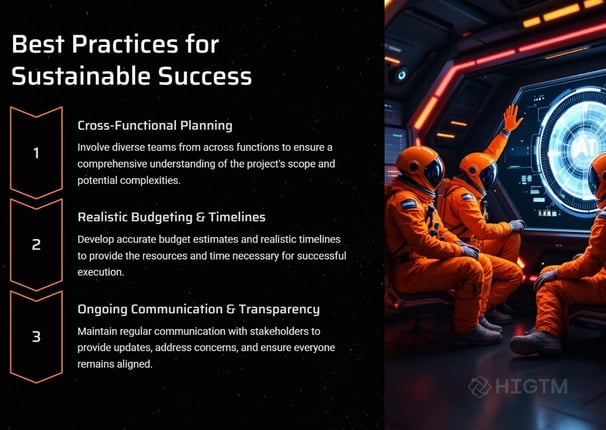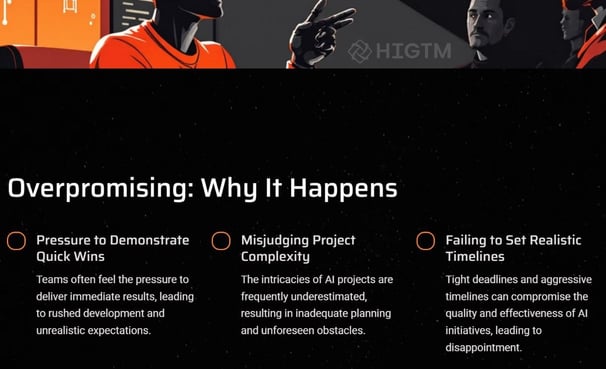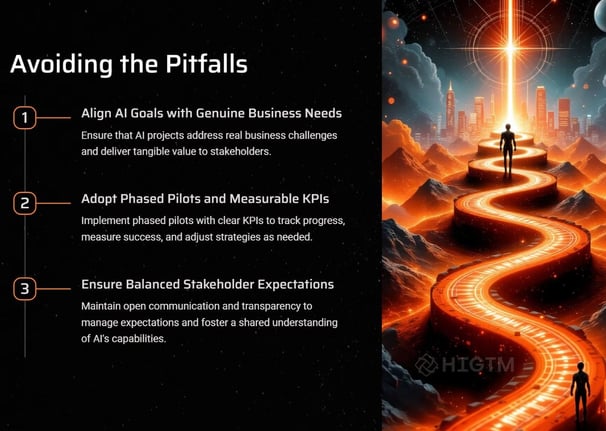24. Avoiding Common AI Pitfalls: How SMEs Can Stop Overpromising and Start Delivering Sustainable Results
Bold AI promises can captivate decision-makers, but inflated projections often lead to unmet expectations, wasted budgets, and eroded trust. For small and medium-sized enterprises (SMEs), it’s crucial to avoid the cycle of overpromising and underdelivering. This in-depth guide shows common traps—and how to sidestep them by planning responsibly, setting realistic goals, and building momentum through incremental wins.
Q1: FOUNDATIONS OF AI IN SME MANAGEMENT - CHAPTER 1 (DAYS 1–31): CORE AI CONCEPTS & VALUE PROPOSITION
Gary Stoyanov PhD
1/24/20254 min read

1. The Appeal of Bold AI Promises
1.1 The Allure of “Big Wins”
AI hype can create visions of dramatic cost savings or revenue boosts. Stakeholders push for quick demos or prototypes, hoping to see transformation in record time. While excitement is beneficial, it can turn harmful if not grounded in feasibility studies.
1.2 The Peril of Instant Gratification
Business leaders want fast proof that AI investments pay off. This drive can lead teams to underestimate complexity or skip thorough data validation. In the rush to show results, corners get cut.
2. Common Overpromising Scenarios
2.1 Vague or Sweeping Goals
Examples include “We’ll reduce costs by 50%” or “We’ll deploy chatbots across all departments next month.” Grand claims are easy to announce but hard to execute. When deadlines arrive, the gap between hype and reality stands out.
2.2 Misjudging Data Quality
Projects assume high-quality, readily available data. In reality, many SMEs struggle with siloed or inconsistent information. Overlooking these issues leads to inaccurate models or delays in building workable solutions.
2.3 Overlooking Resource Gaps
Teams might lack specialized roles like MLOps engineers or data stewards. If no budget exists for hiring or training, AI goals won’t materialize on schedule.
3. Underdelivering: The Fallout
3.1 Stakeholder Disillusionment
When a touted AI project collapses or drastically underperforms, executives or investors question future AI requests. Trust erodes, making it harder to secure next-stage funding or leadership support.
3.2 Team Burnout
Employees who scramble to meet impossible timelines become stressed. Failed projects demoralize staff, especially if they invested late nights in an initiative that never bore fruit.
3.3 Blocked AI Maturity
Overpromising fosters an environment where minor wins get overshadowed by big failures. That dynamic prevents healthy AI adoption cycles and stops SMEs from scaling beneficial uses.
4. Signs You’re Heading Off Track
4.1 Loose or Shifting Scope
Projects with frequently changing or unclear objectives often struggle to deliver coherent results. If no one can articulate the “must-haves” and success metrics, the project grows unmanageably.
4.2 No Feasibility Validation
An AI initiative with uncertain data integrity or a mismatch between skillsets and needed capabilities raises red flags. Immediate resource shortfalls indicate impending shortfall in outcomes too.
4.3 Over-Reliance on External Vendors
Third-party solutions can be valuable, but blind trust in unproven tools sets up disappointment. Vetting vendor references or pilot testing is essential before signing hefty contracts.
5. Avoiding Overpromising
5.1 Align Goals with Practical Needs
Before setting any ambitious targets, anchor them to measurable business impact.
Examples:
Customer Retention: Aim for a 5–10% decrease in churn through AI-based segmentation.
Operational Efficiency: Target a modest 15% reduction in manual tasks rather than proclaiming 60% overnight cuts.
5.2 Use Phased, Realistic Roadmaps
Split big ideas into smaller steps:
Pilot: Validate core viability.
Scaling: Add complexity or more users only after initial success.
Continuous Refinement: Extend functionality or optimize performance once consistent results appear.
5.3 Conduct Early Feasibility Checks
Data Assessment: Evaluate cleanliness, consistency, and coverage.
Skill Inventory: Check if you have roles for data ops, model building, and deployment.
Technical Constraints: Verify if existing infrastructure supports chosen AI frameworks.
6. Reducing Underdelivery Risks
6.1 Implement Rigorous Validation
Set tangible Key Performance Indicators (KPIs) from the start. Track progress monthly or quarterly to catch signs of falling behind.
6.2 Transparent Communication
A continuous update cycle with sponsors and teams avoids last-minute shocks. If issues arise, realigning timelines or recalibrating scope can salvage trust.
6.3 Build from Small Wins
Delight stakeholders by achieving smaller milestones—like automating one manual task that saves 2–3 hours daily. Visible progress fosters confidence in deeper AI investments.
7. Financial and Operational Safeguards
7.1 Budget Contingencies
A 10–20% budget buffer for unforeseen obstacles—like extra data preparation or sudden vendor changes—keeps projects afloat.
7.2 Clear Contractual Agreements
For external partnerships or software licenses, define success criteria, deliverables, and accountability. If vendors promise advanced functionalities, ensure your contract states timelines and penalties if not met.
7.3 Regular ROI Audits
Review whether cost savings or revenue gains align with AI projections. If discrepancies emerge, refine or pivot promptly.
8. Examples of Overpromising and Corrective Action
8.1 Chatbot Project Gone Awry
Scenario: A services firm commits to a “fully automated” AI chatbot, pledging it will handle 90% of inquiries within two months. Delays in training data hamper performance. Real fix: They re-scope the project to handle only simple FAQs first, integrating human fallback for more complex queries.
8.2 Inventory Optimization with Flawed Data
Scenario: A retail SME claims AI will cut 50% of overstock. After deployment, inaccurate supplier data cripples the algorithm. Real fix: Conduct thorough data cleansing and pilot with select product lines to gain initial accuracy.
9. Best Practices for Sustainable AI Projects
Realistic Timelines: Match development cycles to the complexity of the use case.
Cross-Functional Teams: Invite marketing, finance, operations, and IT early, so blind spots are minimized.
Candid Risk Assessment: Identify potential resource, data, or skill gaps and incorporate solutions into your plan.
Adaptive Learning: Gather continuous feedback from each phase, enabling dynamic improvements or re-scopes.
10. Building an Accountability Framework
10.1 Scope Documentation
A concise statement that pinpoints objectives, target metrics, and deadlines. Keep it visible to all stakeholders.
10.2 Milestone Reviews
Set checkpoints—like a working prototype in six weeks or a partial rollout in three months. Reassess feasibility at each stage and course-correct if needed.
10.3 Post-Deployment Analysis
After an AI solution goes live, measure real usage and ROI for at least several weeks. Compare results to the initial pitch. Document any variances to sharpen future estimates.






11. Fostering a Balanced Culture
Balance is key. Teams should remain confident yet grounded in tangible action steps. Overly conservative goals might dampen innovation, but unbridled promises lead to disappointment. A culture of realistic optimism emerges when leaders set thoughtful aspirations, back them with data-driven checks, and openly address risks.
Looking for expert guidance to align AI ambition with realistic roadmaps?
Contact us and let’s map out goals, resources, and timelines that ensure you meet the high expectations AI deserves—without the pitfalls of overhype and underdelivery.
Turn AI into ROI — Win Faster with HIGTM.
Consult with us to discuss how to manage and grow your business operations with AI.
© 2025 HIGTM. All rights reserved.
